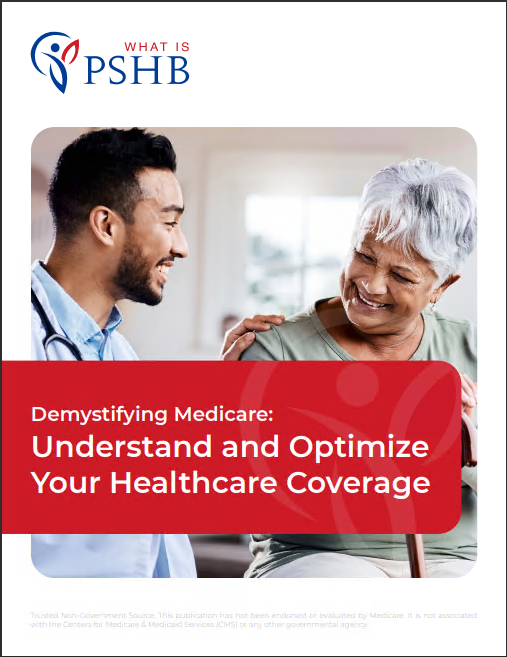Key Takeaways:
-
Enrolling in Medicare Part B alongside your PSHB plan can help you manage healthcare costs and unlock added benefits.
-
Understanding how PSHB and Medicare Part B work together ensures a better healthcare experience and long-term financial stability.
Why Medicare Part B Enrollment Is Crucial for PSHB Enrollees
If you’re part of the Postal Service Health Benefits (PSHB) program, it’s essential to understand how Medicare Part B fits into your overall healthcare plan. Medicare Part B covers outpatient care, medical services, and preventive treatments—services that complement your PSHB coverage. When you coordinate the two, you’re not just enhancing your access to care; you’re also making smarter financial decisions that could save you money over time.
Let’s break it down so you know exactly why this enrollment matters and how it impacts both your immediate budget and long-term savings.
What Is Medicare Part B, and How Does It Fit with PSHB?
Medicare Part B is a component of Original Medicare that provides coverage for outpatient services, including doctor visits, diagnostic tests, and preventive care. For PSHB enrollees who are Medicare-eligible, signing up for Part B creates a coordinated system where your PSHB plan and Medicare work together to minimize out-of-pocket costs.
When you enroll in Medicare Part B, PSHB plans often reduce or waive certain cost-sharing requirements. This means lower copayments, reduced deductibles, and fewer out-of-pocket expenses for covered services. If you choose not to enroll in Part B, however, you may be responsible for higher costs under your PSHB plan alone.
A Quick Overview of Medicare Part B Coverage
Medicare Part B covers essential services like:
-
Physician services
-
Outpatient hospital care
-
Preventive services (e.g., screenings, flu shots)
-
Durable medical equipment (e.g., wheelchairs)
Combining this coverage with your PSHB plan can ensure that most, if not all, of these costs are fully covered.
The Cost of Skipping Medicare Part B
Skipping Medicare Part B might seem like a good way to save on monthly premiums, but it can actually cost you more in the long run. Without Medicare Part B, your PSHB plan might not cover as much, leaving you to pay higher out-of-pocket costs for services Part B would have covered.
Late Enrollment Penalties
If you delay signing up for Medicare Part B when first eligible, you’ll face a permanent penalty. This penalty increases your monthly Part B premium by 10% for each 12-month period you were eligible but didn’t enroll. Over time, these higher premiums can add up significantly, eating into your retirement savings.
Coordination of Benefits
Medicare Part B acts as your primary payer once you’re retired and Medicare-eligible. If you don’t enroll, PSHB becomes your primary payer, which can increase your financial burden. Coordination of benefits ensures that Medicare pays first, reducing the amount your PSHB plan has to cover—and lowering your out-of-pocket costs in the process.
The Financial Impact of Dual Enrollment
One of the biggest advantages of enrolling in both PSHB and Medicare Part B is the potential for substantial cost savings. Here’s how these two programs work together to protect your wallet:
Reduced Out-of-Pocket Expenses
By enrolling in Medicare Part B, you’ll find that many of your out-of-pocket expenses, such as copayments and deductibles, are significantly reduced. For example, PSHB plans often waive deductibles for enrollees with Medicare Part B. This means you can access healthcare services without worrying about paying large sums upfront.
Prescription Drug Savings
If you’re eligible for Medicare Part D coverage (often included with PSHB plans), combining this with Part B can help streamline prescription costs. With the elimination of the Medicare Part D coverage gap (donut hole) in 2025, out-of-pocket prescription drug costs are capped at $2,000 annually. This coordinated approach ensures you’re paying as little as possible for medications.
Enrollment Timelines and Special Considerations
Understanding the enrollment periods for Medicare Part B is essential to avoid penalties and gaps in coverage. Let’s look at the key timelines:
Initial Enrollment Period (IEP)
The IEP lasts for seven months: three months before, the month of, and three months after your 65th birthday. If you enroll during this period, your coverage starts as early as the first day of your birthday month (or the first day of the following month if you enroll later).
Special Enrollment Period (SEP)
If you’re still working when you turn 65 and covered under an employer-sponsored plan, you can delay Medicare Part B enrollment without penalty. Once you leave your job, you’ll have an eight-month SEP to enroll in Part B. This is a crucial window for PSHB enrollees to ensure a seamless transition to Medicare coordination.
General Enrollment Period (GEP)
If you miss the IEP or SEP, you can enroll in Medicare Part B during the GEP, which runs from January 1 to March 31 each year. However, coverage won’t start until July, and you may face late enrollment penalties.
Benefits Beyond Financial Savings
While cost savings are a significant benefit, enrolling in Medicare Part B also improves your access to care. Here’s how:
Comprehensive Coverage
Combining PSHB with Medicare Part B provides more comprehensive coverage, including preventive care that may not be fully covered under PSHB alone. Regular screenings and checkups help detect health issues early, potentially saving you from more costly treatments down the line.
Peace of Mind
Knowing that your healthcare needs are covered can reduce stress and allow you to focus on enjoying retirement. You won’t have to worry about unexpected medical bills disrupting your financial plans.
Provider Flexibility
Medicare Part B offers access to a wide network of providers, giving you more choices when selecting doctors, specialists, and hospitals. This flexibility is especially valuable if you’re traveling or need specialized care.
Making the Most of Your PSHB and Medicare Part B Benefits
To get the most out of your dual enrollment, follow these tips:
Review Your PSHB Plan
Every PSHB plan has unique cost-sharing arrangements and benefits for Medicare enrollees. Take the time to review your plan’s brochure to understand how it coordinates with Medicare Part B. Look for perks like waived deductibles, lower premiums, or additional supplemental benefits.
Track Important Dates
Keep track of key enrollment deadlines to avoid penalties and coverage gaps. Set reminders for your IEP, SEP, or GEP as needed.
Use Preventive Services
Medicare Part B offers a wide range of preventive services at no additional cost, including screenings and vaccines. Take advantage of these to stay healthy and avoid costly medical issues in the future.
Monitor Out-of-Pocket Spending
Even with coordinated coverage, it’s essential to monitor your healthcare expenses. Check your plan’s out-of-pocket maximums and use this information to plan your budget effectively.
PSHB and Medicare Part B: A Winning Combination for Postal Workers
Enrolling in Medicare Part B while maintaining your PSHB plan isn’t just a good idea; it’s a smart strategy for managing your healthcare costs and ensuring comprehensive coverage. By coordinating these two programs, you’ll unlock significant financial savings, gain access to top-tier medical services, and enjoy peace of mind knowing that your health and budget are secure.






